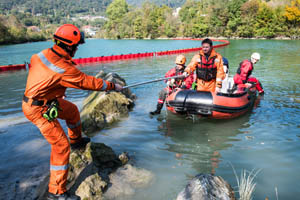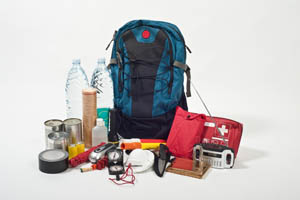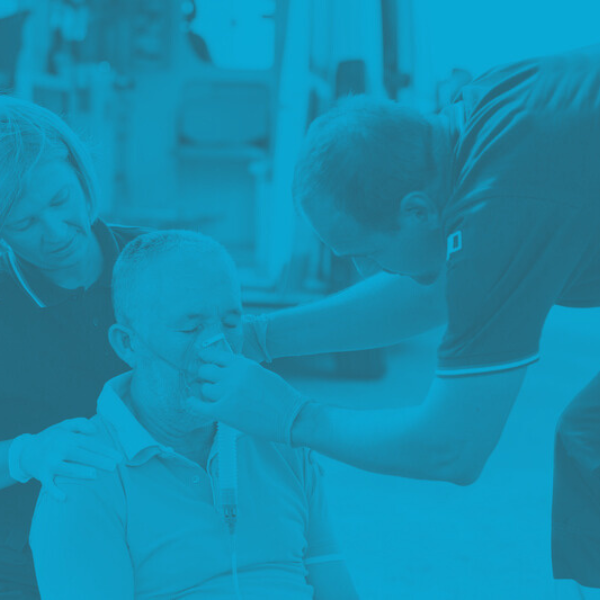Hurricane Season First Aid Kit & Certification Benefits
Hurricane Season First Aid Kit & Certification Benefits

by Greta Kviklyte
Life Saver, AMC
Co-authored by Kim Murray, RN, M.S.
posted on Sep 12, 2019, at 11:06 pm
Hurricanes form a basic part of life for those along the Atlantic coast, and the recent history of Hurricane Dorian reveals how unpredictable these storms can become. As August drew to a close, Dorian resembled nothing more than a Tropical Depression, but within days, the storm achieved hurricane strength. Before making landfall in the Bahamas, it grew to become the most powerful hurricane to ever strike the country, and it laid eyes upon Florida.
Fortunately, the storm changed direction, but the damage continued in North Carolina, Southeast Virginia and other local areas, notes The Weather Channel. For those without power and shelter, loss of life becomes a real threat.
We offer Online ACLS, PALS and BLS Certification and Renewal
With those memories fresh in the mind, the value of preparedness, including creating and maintaining a First Aid Kit and Certification, such as the program here, feels even greater.
All individuals need to understand the outlook for the Atlantic hurricane season, why recovery relies heavily on the masses, who needs a First Aid Certification, its value, how to create a kit from scratch and a few tips to weather the storm.
A Few Facts About Hurricane Season in the Atlantic
 Hurricane Season technically runs from June 1 through November 30. However, hurricanes have been known to form outside of this span. All hurricanes share a common standard—sustained winds of 74 mph or higher, which can topple buildings, bring untold devastation with rain and an unrelenting storm surge, says CNN. Predictions for the 2019 hurricane season continue to favor an “above-normal” number of named storms.
Hurricane Season technically runs from June 1 through November 30. However, hurricanes have been known to form outside of this span. All hurricanes share a common standard—sustained winds of 74 mph or higher, which can topple buildings, bring untold devastation with rain and an unrelenting storm surge, says CNN. Predictions for the 2019 hurricane season continue to favor an “above-normal” number of named storms.
Even the National Oceanic and Atmospheric Administration (NOAA) updated its predictions in August to indicate a surge of activity that was not mentioned in the original May prediction. In fact, another storm brewing in the open ocean, Tropical Storm Gabrielle, could be the next biggest storm. Regardless of how severe the storm looks, Ready.Gov advises people to prepare ahead of time, gathering enough supplies to last at least three days. This is sound advice, but as seen in the Bahamas, a hurricane could stall.
Those without access to a First Aid Kit could find themselves in a dire situation. News reports from the past few days reveal multiple severe injuries in the Bahamas, including loss of limb. Meanwhile, the death toll had risen to 30, and country officials expect final mortality rates to soar higher. The prolonged lack of access to basic First Aid care for severe injuries, food, water and shelter will cost lives. As explained before in a blog post here, preparation for emergencies is essential.
Recovery Efforts Require Trained Responders
After the storm passes, the real recovery begins. People need help. Moreover, storm surge withdrawal presents a new danger. As the tide retreats to the sea, those without adequate shelter could be swept from the land. In the aftermath, stay vigilant for people in distress.
Drowning from storm surge remains a very real threat after a hurricane. Depending on how far inland the storm moved, rivers may still surge and break prior peak records. Such instances reflect an immediate increase in risk after a storm.
Those with injuries due to debris should be properly cared for, using clean water to rinse wounds, bandage them and prevent further health problems by getting to an appropriate health care facility. Unfortunately, failure to follow the instructions in your First Aid Kit could lead to subsequent infections.
What Is First Aid and Who Needs to Get a Certification
Maintaining a First Aid Kit and Certification demonstrates a person’s willingness to go the extra mile to help others. First Aid provides the life-saving skills to help people survive until professional help arrives. Depending on the severity of the injury, the use of additional measures, such as creating a split or applying a tourniquet, may be necessary.
While keeping a First Aid Kit in vehicles, the home and the workplace remains a valuable piece of advice, it is essential to know how to use the supplies correctly. Fortunately, most off-the-shelf kits include basic instructions for emergency care. However, more serious injuries may require more advanced knowledge of life-saving skills.
For example, the use of Cardiopulmonary Resuscitation (CPR) for those that experience drowning or cardiac arrest during or in the time following landfall. Even those without a medical background could save lives when a hurricane strikes. Most importantly, areas hit hardest by a hurricane will have limited first responders and medical personnel. It may be impossible to obtain timely care from a hospital or other emergency center. Therefore, everyone in the area becomes a first responder.
Community members should leverage First Aid Kits and Certification to be fully prepared for any disaster. This goes well beyond the risk for hurricanes. Heavy rains not associated with tropical storms, landslides, earthquakes and even manmade disasters may occur. Any day can become an emergency, and those with advanced training of how to use a First Aid Kit and provide care can become a stand-in responder.
How to Build a Basic First Aid Kit
A basic hurricane survival kit is comparable to a First Aid kit on steroids. The hurricane survival kit must include a basic First Aid Kit with at least the following:
- Absorbent compress dressings. These dressings resemble padded gauze, perfect for absorbing blood and use in preventing infection to large wounds.
- Adhesive bandages of different sizes. In addition to basic, rectangular bandages, include specific types, such as eye, finger and knuckle bandages. This will help you care for injuries of all sizes.
- Adhesive cloth tape. Adhesive cloth take eliminates the risk of reaction to latex tape, and it can be easily removed without risking damage to skin—a key consideration for caring for the elderly.
- Sterile, non-latex gloves. Wear sterile gloves when providing care to any open wound or when contact with blood or bodily fluids may be likely.
Medical shears or blunt-tip scissors. Obviously, an emergency causes a rush on supplies, but in a pinch, blunt-tip children’s scissors make an excellent substitute. - Antibiotic ointment. Antibiotic ointment may come in disposable packets or tubes. Also, include cotton-tipped applicators if your kit contains tubes of any medication or ointment.
- Applicable medical equipment, such as lancets, inhalers and more. These instruments are essential for those with certain medical conditions. It may also be prudent to ensure an adequate supply of oxygen canisters in the home prior to the storm’s arrival.
- Digital, instant-read thermometer. A digital thermometer is the easiest way to identify those with early signs of infection, such as a fever.
- Prescription and over-the-counter medications. Keep a three-day supply of medications in the First Aid Kit. Check the kit medications for expiration dates at least every three months, regardless of the time of year.
- Cleansing wipes and hand sanitizer. Cleansing wipes and hand sanitizer are excellent resources for when clean water is in short supply.
- Aloe Vera gel. Aloe is most commonly used for burns, but it also can alleviate itching from insect bites and stings too.
- Personal Protective Equipment (PPE). For instance, a CPR mask and other PPE, as explained in a previous blog here, will help prevent the spread of illness and help avoid bloodborne pathogens.
Also, create notecards containing health and medical information for each family member.
 For example, a family member medical card should include name, date of birth, medical allergies, current medication list, the name of the primary care physician and family member contact information. If desired, include a copy of your health insurance cards as well. Seal these cards within a plastic, waterproof sandwich bag. This will prevent damage from water. Also, consider investing in a waterproof First Aid Kit or container, available on Amazon. Floodwaters carry countless contaminants that may cause infections, rash, gastrointestinal illnesses and more, explains CDC.Gov, so avoid using flood water for any wound cleaning or drinking.
For example, a family member medical card should include name, date of birth, medical allergies, current medication list, the name of the primary care physician and family member contact information. If desired, include a copy of your health insurance cards as well. Seal these cards within a plastic, waterproof sandwich bag. This will prevent damage from water. Also, consider investing in a waterproof First Aid Kit or container, available on Amazon. Floodwaters carry countless contaminants that may cause infections, rash, gastrointestinal illnesses and more, explains CDC.Gov, so avoid using flood water for any wound cleaning or drinking.
Extra Hurricane Preparedness Steps to Take
The exact hurricane preparedness steps to take depend on your location and susceptibility to both hurricane winds, flooding and storm surge. However, everyone can be more prepared by following the steps detailed by the National Hurricane Center. These include:
-
- Gather your emergency supplies. Supplies include plenty of drinking water, nonperishable food and batteries.
- Create a disaster plan, such as a Family Emergency Plan. This plan should detail where family members will meet and how to evacuate a town if needed.
- Take evacuation orders seriously. Regardless of past luck, no one knows if an incoming hurricane could be your last. Always listen to officials, following evacuation orders when given.
- Set a neutral gathering area. Hurricanes can dump rain hundreds of miles inland. Ensure your family knows how to travel along evacuation routes, including directions for avoiding low-lying areas that may flood.
- Remember your pets. Pack enough pet food, water and medications, if applicable, to make it through the storm.
Take appropriate damage prevention steps for your home. For example, board your windows, and if you know of elderly citizens that need assistance, lend a helping hand. - Know how to use a generator safely. Above all else, never run an electricity generator indoors or areas with poor ventilation. Exhaust gases contain carbon monoxide, which is a silent, odorless killer.
- Listen for the all clear. Those with NOAA emergency radios can receive updates regarding storm locations and conditions. Even when the storm seems to pass, remember the outer bands can still spawn severe weather, including tornadoes.
Enroll in Your First Aid Training Course to Be Ready for the Next Storm Now
Hurricanes remain a subject of much debate, and as climates evolve, the threat of future storms may grow more severe. While forecasts provide the most accurate predictions three to five days prior to landfall, Hurricane Dorian went by the wayside. The storm strengthened faster than anticipated and caused widespread devastation. As the Bahamian people try to recover, heroes will rise in everyday citizens, capable of helping others with First Aid and much more. Do not wait until a storm is on the horizon to stock your First Aid Kit. Take proactive measures to prepare, and ensure your skills are ready to deploy.
Have you ever endured the strength of a hurricane and needed to use your emergency First Aid Kit to make it through the event? If so, share your survival stories and experiences, as well as this article to social media. Awareness is power when it comes to hurricanes. Build your kit, know the threat, and prepare in advance. Also, remember to enroll in your hurricane preparedness First Aid program, as found here, now.



